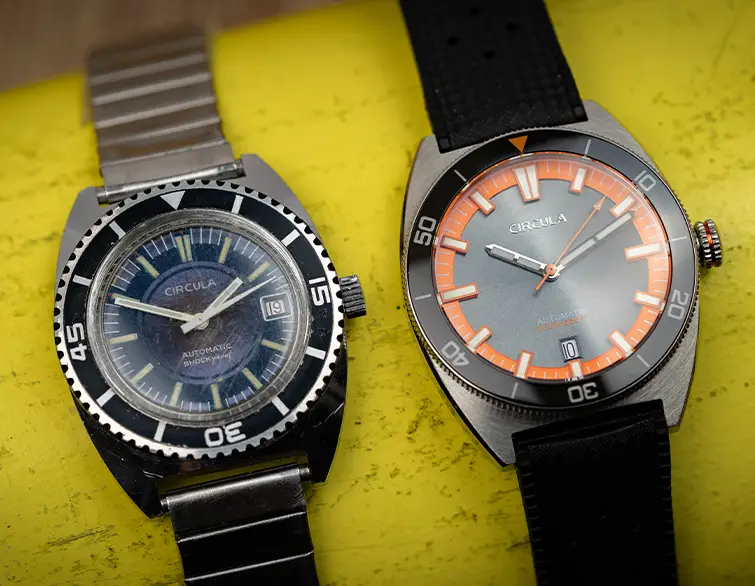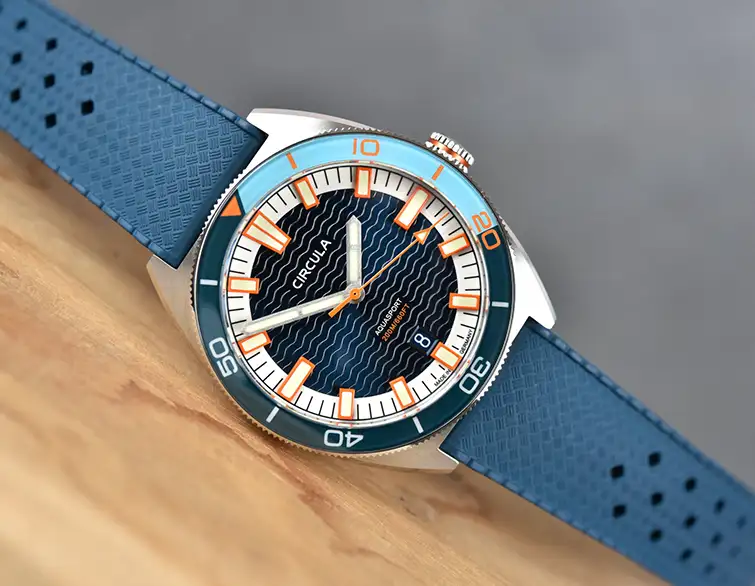Saphirglas, Mineralglas oder Hesalitglas?
Vor- und Nachteile
Hesalitglas
vor allem in Vintage-Uhren zu finden
Die vor einigen Jahrzehnten weit verbreiteten Hesalitgläser (z.B. in Uhren der 50er-Jahre) werden heute nur noch sehr selten verbaut – vereinzelt setzen Uhrenhersteller aber auch bei neuen Modellen noch auf gewölbtes Hesalitglas, um den Retro-Charakter zu unterstreichen. Hesalitglas ist im Vergleich zu Saphirglas etwa 50 Mal weicher und damit sehr kratzempfindlich, auf der anderen Seite aber sehr elastisch und damit sehr bruchsicher bzw. schlagfest. Oberflächliche Kratzer lassen sich in Eigenregie mit einer Polierpaste (z.B. Polywatch) und etwas Geduld rauspolieren.

Mineralglas
meistens gehärtet
Chemisch betrachtet kommt Mineralglas Fensterglas sehr nahe – Mineralglas ist daher naturgemäß weniger bruchsicher als Hesalitglas. Heute werden in Uhren meistens Mineralgläser verbaut, die durch spezielle Verfahren bei der Herstellung (z.B. durch Erhitzen oder Bedampfen) an ihrer Oberfläche widerstandsfähiger gemacht werden. In Produktbeschreibungen liest man dann häufig von gehärtetem Mineralglas. Das Glas erhält durch die Beschichtung eine Härte von etwa 900 HV (Härte nach Vickers), bleibt aber dennoch deutlich anfälliger für Kratzer als Saphirglas. Saphirglas das Nonplusultra hinsichtlich Kratzfestigkeit Am beständigsten gegen Kratzer ist das sogenannte Saphirglas, wobei die Bezeichnung etwas irreführend ist, da Saphirglas kein Glas im eigentlichen Sinne ist. Es ist vielmehr ein synthetisches Produkt, welches im aufwändigen, sogenannten Verneuil-Verfahren aus hochreinem synthetischen Aluminiumoxid hergestellt wird. Saphirglas erreicht eine Härte von etwa 2000 HV – doppelt so viel wie Mineralglas. Saphirglas kann daher nur von wenigen Materialien zerkratzt werden, dazu gehört beispielsweise echter Diamant mit 4.500 bis 10.000 HV. Zum Vergleich: Edelstahl kommt auf ungefähr 220 HV.
Saphirglas
Das Nonplusultra hinsichtlich Kratzfestigkeit
Am beständigsten gegen Kratzer ist das sogenannte Saphirglas, wobei die Bezeichnung etwas irreführend ist, da Saphirglas kein Glas im eigentlichen Sinne ist. Es ist vielmehr ein synthetisches Produkt, welches im aufwändigen, sogenannten Verneuil-Verfahren aus hochreinem synthetischen Aluminiumoxid hergestellt wird. Saphirglas erreicht eine Härte von etwa 2000 HV – doppelt so viel wie Mineralglas.
Saphirglas kann daher nur von wenigen Materialien zerkratzt werden, dazu gehört beispielsweise echter Diamant mit 4.500 bis 10.000 HV. Zum Vergleich: Edelstahl kommt auf ungefähr 220 HV. Ein Nachteil von Saphirglas ist die vergleichsweise starke Brechung des Lichtes, wodurch es zu Reflexionen kommen kann, die die Ablesbarkeit einer Uhr einschränken können. Um dies zu vermeiden, sind Saphirgläser von hochwertigen Uhren, wie auch bei Circula, doppelt bzw. beidseitig entspiegelt. Genauer gesagt werden bei Circula-Uhren die Innen- und die Außenseite des Saphirglases durch Vakuumverdampfung in einem Ofen entspiegelt. Durch dieses Verfahren werden 99% der vom Auge wahrgenommenen Reflexe beseitigt und die Ablesbarkeit wird stark verbessert.
Kratzer in Mineralglas oder Saphirglas lassen sich nicht ohne Maschinen entfernen. Am sinnvollsten bei diesen Glas-Arten ist immer ein Tausch.
Gewölbtes (bombiertes) Saphirglas
aufwendig in der Produktion
Flaches bzw. planes Saphirglas ist vergleichsweise einfach zu produzieren, da es direkt mit Hilfe von Diamantklingen scheibchenweise „heruntergeschnitten“ werden kann. Im Vergleich dazu ist die Herstellung gewölbter bzw. bombierter Uhrengläser deutlich teurer. Der Grund: Um gewölbtes Saphirglas produzieren zu können muss die Vorder- und die Rückseite des Glases aufwendig durch Schleifen bearbeitet werden.
Für die Circula SuperSport, AquaSport und ProTrail verbauen wir trotz dieser deutlichen Mehrkosten für uns ein gewölbtes, entspiegeltes Saphirglas – als kratzfeste Hommage an das Design der großen Uhrenklassiker.
Saphirglas einfach selbst erkennen
Ob die Lieblingsuhr mit Saphirglas kommt, kann man übrigens ganz einfach selbst mit der sogenannten Wassertropfenmethode prüfen: Dazu tupft man einen Tropfen Wasser auf die Oberfläche des Uhrglases und beobachtet dessen Verhalten. Bleibt der Tropfen kugelförmig handelt es sich um Saphirglas. Breitet er sich aus und zerfließt, ist es Mineralglas.
Saphirglas vs. Mineralglas vs. Hesalitglas
Unterschiede im Vergleich
Zusammenfassend lassen sich die Vorteile und Nachteile bei den verschiedenen Uhrenglas-Typen wie folgt beschreiben:
| Saphirglas | Mineralglas | Kunststoffglas/ Haslitglas | |
| Kratzempfindlichkeit | Unempfindlich (ca. 2000 HV) | Empfindlich (ca. 900 HV) | Sehr empfindlich (ca. 40 HV) |
| Bruchsicherheit | Relativ bruchsicher | Bruchsicher | Sehr bruchsicher |
| Spiegelung | Spiegelt stark (außer es ist entspiegelt) | Spiegelt relativ wenig | Spiegelt sehr wenig |
| Pflege (Entfernen von Kratzern) | Nicht möglich (nur Tausch) | Nicht möglich (nur Tausch) | Ja, polierbar mit z.B. Polywatch Polierpaste |
| Kosten | Relativ teuer | Relativ günstig | Sehr günstig |

